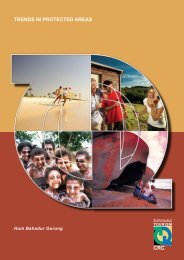icolls - Sustainable Tourism CRC
icolls - Sustainable Tourism CRC
icolls - Sustainable Tourism CRC
You also want an ePaper? Increase the reach of your titles
YUMPU automatically turns print PDFs into web optimized ePapers that Google loves.
ECOLOGY, THREATS AND MANAGEMENT OPTIONS FOR SMALL ESTUARIES AND ICOLLS<br />
might be expected between ICOLLs and estuaries, owing to high algal production in ICOLLs compared to<br />
estuaries. Furthermore, variation in habitat complexity and opening and closing regimes are likely to a large<br />
degree of variability of habitats supporting the food resources of fish between ICOLLs.<br />
The encroachment of urban centres around ICOLLs has resulted in the common practice of local authorities<br />
artificially opening these lakes and lagoons (predominantly for flood mitigation and water quality concerns)<br />
without any definitive knowledge of the short and long-term impacts on aquatic community assemblages (Lugg<br />
et al. 1998). In light of the abundance and importance of ICOLLs, and the paucity of information, an increased<br />
understanding of the ecology and trophic interactions within these systems is required to ensure sustainable<br />
management of Australia’s coastal fisheries. Understanding the effects of intermittent opening regimes on the<br />
dietary composition of commercially important teleosts will allow more informed decision making regarding the<br />
optimal timing and duration of artificial opening practices.<br />
In this chapter we present the findings of a study that investigated the diets of commercially important fish<br />
species in two ICOLLs in northern New South Wales. We used gut contents analysis and stable isotope<br />
techniques to reconstruct fish diets on the basis of resident and available prey items. Our primary goal was to<br />
assess the breadth and differences in dietary composition within four commercially and recreationally valuable<br />
fish species. This study of fish diets in response to the variable influence of marine, terrestrial and freshwater<br />
environments created by intermittent opening events in ICOLLs is completely novel.<br />
Materials and Methods<br />
Study Species<br />
The four fish species that formed the focus of this study were yellowfin bream (Acanthopagrus australis), dusky<br />
flathead (Platycephalus fuscus), sand whiting (Sillago ciliata) and sea mullet (Mugil cephalus). These species<br />
were selected due to their known abundance in ICOLLs and their importance to both recreational and<br />
commercial fisheries (Pollard 1994b). Furthermore, the diets of these species (or closely related species) have<br />
previously been assessed in estuarine and coastal waters and reported in the literature, thereby allowing<br />
comparisons to be drawn across a variety of aquatic systems and identifying dietary compositional differences to<br />
be analysed.<br />
Study Area<br />
The four target species were collected from two ICOLLs located within Byron Shire on the New South Wales<br />
north coast, 790kms north of Sydney (Figure 3). Belongil and Tallows Creek are close to the urban settlements<br />
of Byron Bay and Suffolk Park, respectively. Belongil Creek, located just north of Byron Bay, includes a<br />
relatively small catchment area of 18km 2 and has an annual rainfall of 1850mm (NSW Department of Land and<br />
Water Conservation 2000). Tallows Creek is situated south of Cape Byron and the township of Byron Bay. Both<br />
systems have water quality that is impacted by acid-sulphate soils, stormwater run-off and point source pollution<br />
derived from residential, industrial and agricultural land-use within their respective catchments (NSW<br />
Department of Land and Water Conservation 2000). In addition, an STP discharges treated wastewater directly<br />
into Tallows Creek.<br />
Sampling for the four target fish species occurred on a series of dates between 27 November and 18<br />
December 2003. One study site at the mouth of each ICOLL was selected, thereby reducing the effects of any<br />
spatial variability that may exist within each system. At the time of sampling Belongil Creek was open to the<br />
ocean, whilst Tallows Creek had been closed for a period of time.<br />
At the time of sampling, the tidally active Belongil Creek had salinity levels near that of seawater (Table 7).<br />
A small drop in salinity from 29.0ppK to 26.9ppK was evidenced over a falling tide, highlighting the variability<br />
of physical and chemical conditions in this tidally influenced system. We also noted a dramatic change in water<br />
clarity over the tidal cycle, with clarity declining over a falling tide (W. Hadwen and G. Russell, personal<br />
observation). In contrast, the closed Tallows Creek had consistent and very low salinities (Table 7). Water clarity<br />
within Tallows Creek was affected by tannin-stained water and a high suspended solids load caused by<br />
discharged treated sewage (McAlister et al. 2000).<br />
37











